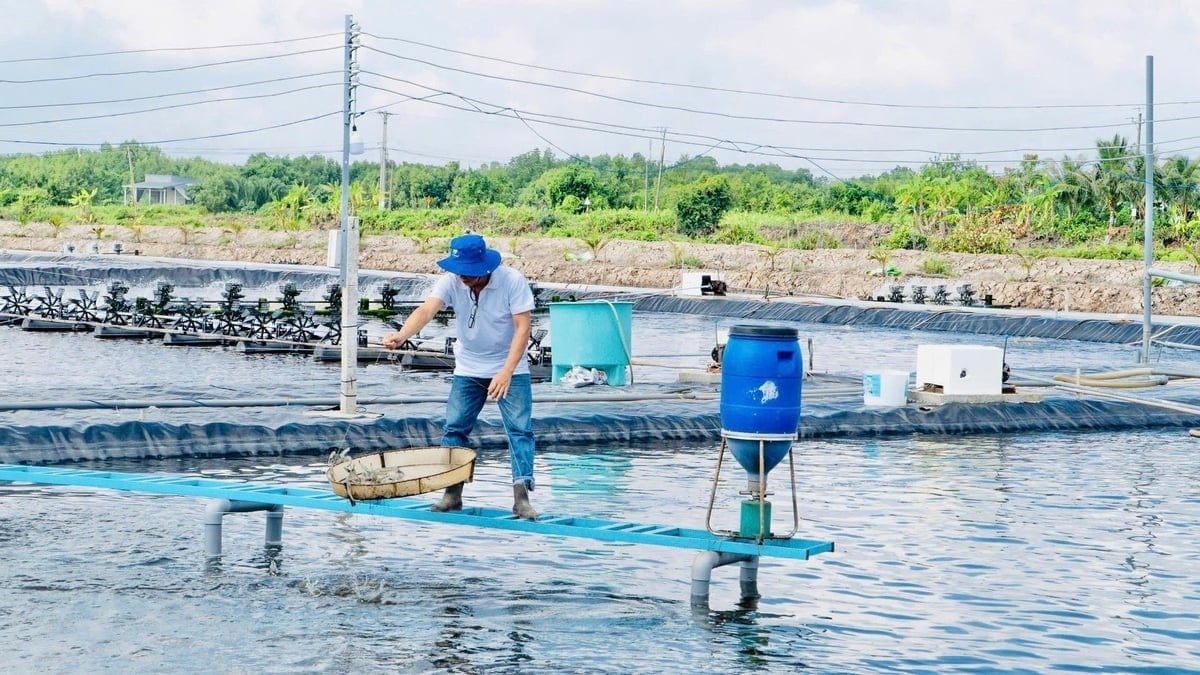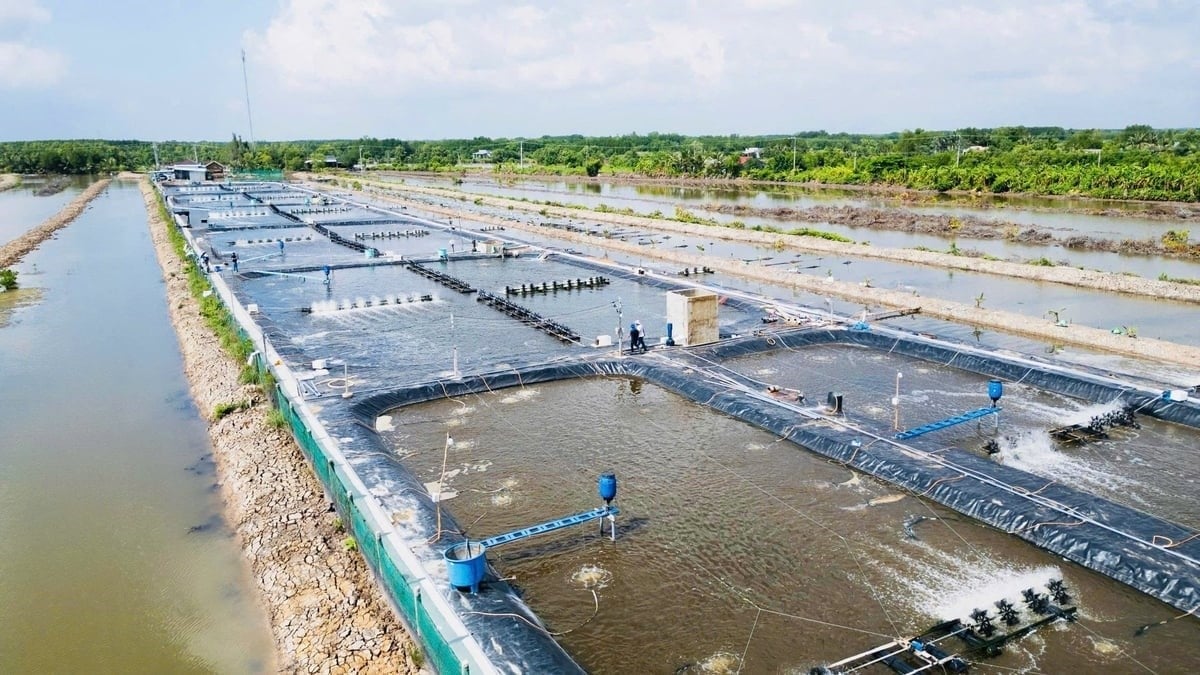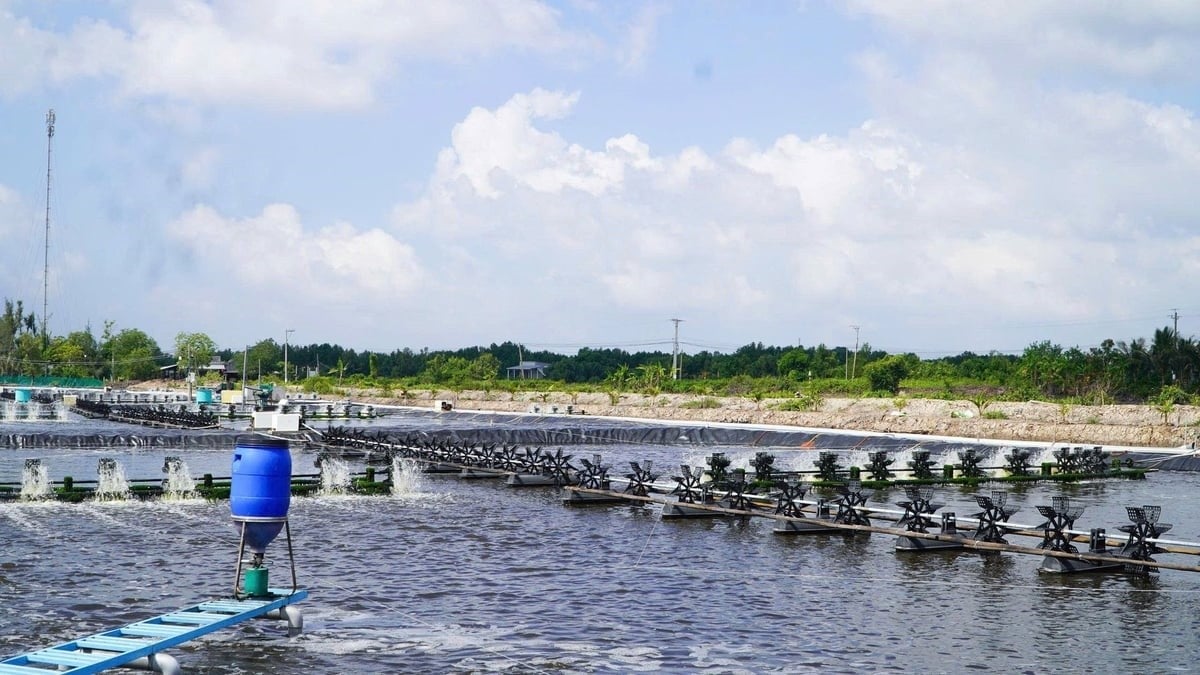December 4, 2025 | 13:56 GMT +7
December 4, 2025 | 13:56 GMT +7
Hotline: 0913.378.918
December 4, 2025 | 13:56 GMT +7
Hotline: 0913.378.918
At the southernmost land of the country, the zero-discharge recirculating shrimp farming model is bringing fresh momentum to Ca Mau's fisheries industry. By applying modern technology, farmers not only optimize costs and reduce environmental risks but also open a sustainable direction for Vietnamese shrimp.

A team of experts supports farmers in applying the model. Photo: Trong Linh.
A typical example is the super-intensive white-leg shrimp farming model applying RAS-IMTA recirculating technology, which has helped farmers increase productivity, protect the environment, and meet the stringent requirements of export markets.
Ca Mau currently has over 450,000 hectares of shrimp farming, most of which are still practiced under traditional extensive and super-intensive methods. While these methods are familiar, they pose multiple risks, such as disease outbreaks, water pollution, and difficulties in controlling pond environments. Meanwhile, markets are setting increasingly strict requirements on biosecurity, traceability, and environmentally friendly production.
Concerned about these limitations, Mr. Doan Minh Trung in Dat Moi commune, Ca Mau province, boldly applied a closed recirculating shrimp farming model with minimal water change and RAS-IMTA water treatment technology. After more than a year of implementation, Mr. Trung assessed that the model delivered outstanding economic efficiency compared to traditional methods.
"Previously, when farming in earthen ponds, I had to discharge water after each crop to clean the ponds, which negatively affected the surrounding environment. Shrimp typically needed 76 days to reach a size of 60 heads per kilogram. With this model, it takes only 55 days to achieve the same size, shortening the cycle by nearly 20 days, cutting costs, and adding an extra crop each year," Mr. Trung shared.
According to Mr. Huynh Viet Trieu, Chairman of the Dat Moi Commune People's Committee, the locality has piloted the model with two households, both achieving positive results. In the coming period, the commune will coordinate with the provincial Department of Science and Technology to expand the model locally. "This is a new production model that combines economic efficiency with environmental protection and fully aligns with Ca Mau's orientation toward high-tech agricultural development," Mr. Trieu emphasized.

Beyond environmental effectiveness, the model also helps farmers reduce emissions. Photo: Trong Linh.
According to Mr. Quach Van An, Deputy Director of the Ca Mau Department of Science and Technology, the model is being piloted under the project "Mobilizing resources to replicate the technology process of super-intensive, recirculating, low-water-change, bio-safe white-leg shrimp farming." The goal is to reach 100 hectares by 2025 and then expand to 1,000 hectares across the province.
The project applies RAS recirculating farming technology combined with the IMTA multi-species model, which is well-suited to climate change adaptation, reduces investment costs, lowers emissions, and enhances productivity. The model achieves an average survival rate of 85–90%, yields of 40–50 tons per hectare per crop, and a stocking density of 250–300 heads per m². Notably, all wastewater after treatment meets the QCVN 40:2011/BTNMT industrial wastewater standard.
Beyond its environmental effectiveness, the model also reduces CO₂ emissions to below 5 kg CO₂ per kilogram of shrimp, which is an essential factor for exports to high-end markets such as the EU and the U.S. At the same time, the products meet international certifications such as ASC and BAP, ensuring traceability and sustainable development.

The high-tech shrimp farming area is applying the water recirculation model in Ca Mau. Photo: Trong Linh.
Ms. Nguyen Thu Thuy, Director of Sustainable Development Asia at De Heus Co., Ltd., stated, "Since the project was proposed, we have identified it as an opportunity to realize our company's commitment to sustainable development in Vietnam's fisheries industry."
With its Aquaculture Research Center in Vinh Long, put into operation since 2017, and a specialized shrimp feed mill inaugurated in early 2024, De Heus has thoroughly prepared both infrastructure and technical expertise to accompany farmers.
The company is also developing tools to measure emissions at shrimp farms, aiming to ensure data transparency and enhance the value of Vietnamese shrimp in international markets. "We are committed to comprehensive support, from providing feed and technical assistance to integrating water treatment technology and connecting farmers to export markets, toward building a national recirculating shrimp farming model," Ms. Thuy emphasized.

Recirculating shrimp farming – A new direction for Ca Mau fisheries. Photo: Trong Linh.
According to the Ca Mau Department of Science and Technology, RAS-IMTA technology will be one of the breakthrough solutions to minimize environmental pollution and enhance the competitiveness of Vietnamese shrimp. With clear efficiency in costs, productivity, and environmental protection, the model is suitable for large-scale replication, especially in the province’s concentrated farming areas.
"This is a model that creates clean, traceable products meeting export standards while reducing greenhouse gas emissions. Ca Mau is moving toward a green, responsible, and environmentally friendly agriculture, and recirculating shrimp farming is one of the clearest examples," affirmed Mr. Quach Van An.
The Ca Mau Department of Science and Technology is the lead agency for the project. The Department also collaborates with Dr. Nguyen Nhut from the Research Institute for Aquaculture No. II, who is the author of the RAS-IMTA technology, serving as advisor and directly implementing the technology for the project. SAEN Environment and Aquaculture Co., Ltd. is responsible for the technological aspects, while De Heus Co., Ltd. and other partners carry out deployment in the province. The two enterprises have provided crucial resources for the project, including technology, funding, manpower, and technical experts who directly accompany farmers throughout the implementation process.
Translated by Thu Huyen
/2025/12/01/2936-2-222331_70.jpg)
(VAN) Mortgaging his house and giving up a pharmaceutical management career, Mr. Nguyen Quang Duy succeeded in bringing Khanh Hoa's sea grapes to demanding markets such as Japan and the U.S.

(VAN) The large-scale agroforestry investment project aims to develop a leading sustainable agro-industrial center in Angola.
/2025/11/28/3433-1-212821_213.jpg)
(VAN) Many localities across the coconut land of Vinh Long are replicating emission-reducing models in production and daily life, contributing to the targets for emission reduction and green economic development.

(VAN) The green transition is an inevitable path for collective economy to achieve balanced growth and align with global trends.

(VAN) The TH Group is not only Vietnam’s leading clean-milk producer; it is also leaving a strong mark on sustainable development as it pursues the goal of carbon neutrality.
/2025/11/27/3830-1-152901_403.jpg)
(VAN) Dong Nai is developing its key crop areas, expanding planting area codes, and applying high technology to increase the value of agricultural products, aiming at a green and sustainable agriculture.

(VAN) Tay Ninh’s livestock sector is undergoing a major transformation, applying high-tech, closed-loop circular models to build sustainable value chains.